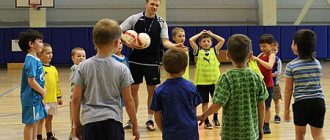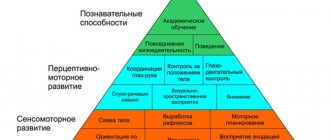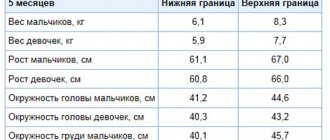All parents dream of their child growing up healthy. Therefore, it is quite natural that during the first years of a baby’s life they pay special attention to the proper organization of his nutrition. Many parents use special tables, count calories, and consult with pediatricians about age-appropriate menus. In the first months of his life, the baby obediently opens his mouth and eats absolutely everything that his mother offers him. But time passes and he develops his own taste preferences and favorite dishes. The baby is trying to “take control” of the feeding process. Today we will talk about how to teach a child to eat independently, how to avoid whims at the table, and what to do if the baby refuses food.
At what age should a child eat on his own?
Some (especially impatient) parents make their first attempts to teach their baby to eat on his own as soon as he is six months old. All their efforts, as a rule, end in complete disappointment and general cleaning of the walls and floor in the kitchen. Which is quite natural. By this age, children have not yet developed coordination of movements and, no matter how hard the child tries, he cannot master this skill.
When should you start teaching your child to eat on his own? According to experts, the optimal age for mastering this skill is one year - plus/minus two months. You should not try to force the child and forcefully “push” the spoon into his hand. But it is not advisable to delay the learning process too much. As practice shows, the older the baby gets, the more difficult it is to interest him. After two years, little fidgets may consciously refuse to eat on their own. They are much more pleased to simply open their mouth condescendingly. So, the optimal age for mastering this skill is considered to be 10-14 months.
- At eight to ten months, you can replace the bottle with a sippy cup. At this age, you can put cookies or soft pieces of fruit in the baby’s hand so that he tries to put them into his mouth on his own.
- By one year, children should master the skill of using a cup and spoon.
- At two years old, a child should confidently use a spoon and actively master the skill of using a fork. At this age, you can already begin to acquaint your child with the rules of etiquette.
How to teach a child to eat himself: specific techniques for parents
I would like to immediately warn all parents that the process of learning the skill of independent feeding is quite lengthy and painstaking. All household members will have to be patient. Spilled soup, porridge smeared on the table, bread crumbs on the floor - a picture that you will have to see every day. Remember, it is not your child’s fault, his coordination is still poorly developed and he also has a hard time. Learning something new is never easy. Praise your child more often, teach him to eat correctly and carefully.
During the learning process, you should not reprimand or scold a child, even if he dropped a plate of porridge on the floor. The baby may get scared and lose all desire to eat on his own. However, parents should not allow self-indulgence at the table. A child should not play with food!
There is probably no need to explain to parents that the child should wash his hands before eating. The sooner you teach him to maintain hygiene, the faster he will form this healthy habit.
Can a child eat in front of the TV?
You should turn off the TV while eating. American scientists conducted a study which found that children who eat food accompanied by scenes from their favorite cartoon chew it poorly and eat significantly less. But as soon as they make this process habitual, they will immediately begin to overeat, absorbing huge amounts of poorly chewed food. They are unlikely to be able to avoid digestive problems in the future.
Why does a child eat very slowly: 2 common reasons When eating, the baby should not be rushed. What if he eats very slowly? As a rule, a child’s slowness is associated with two reasons:
- He is cautious , afraid to hear critical remarks from you.
- He deliberately slows down the process, hoping that your patience will snap and you will feed him yourself. This situation can be corrected in a very simple way - if possible, sit down at the table with the whole family. After finishing your meal, immediately go about your business. Baby Kapusha will not like to be left alone at the table, and he will try to keep up.
Among other things, you need to strictly adhere to the regime and eat food at the same time. Dinner should end two hours before bedtime.
The main rule that all parents must learn is that if the child does not want to eat, you should not force him. No: “A spoon for dad, a spoon for mom.” When hungry, the baby will ask for food and eat it on his own with great pleasure. Child psychotherapist Alison Schaeffer noted that a person can live without food for a week. However, within two hours the young mother begins to think about whether her child is dying of starvation! Agree, quite an ironic remark. But how true!
But if the child has lost his appetite, then you need to determine the reason why the child is not eating well.
Kuznetsova-mother
Kuznetsova-mother ! Do not pay attention to the accusations of those who have not been in the exact same situation as yours. And many of the tips (of course with the best intentions) are given here without taking into account one of the most important points - your child’s increased gag reflex. And this is the main reason that he does not want to eat himself with a spoon - not the mother’s omission or inaction, not the child’s laziness or inability, but his fear of food for fear of choking and vomiting. There are such children, and mothers are not at all to blame for this, but doctors blame it on anything due to illiteracy.
My child and I have the exact same situation as you, and we have behind us a huge number of serious examinations, doctors, information studied on this topic and the experience of our own and others and the kindergarten. The child is completely healthy and well developed mentally and physically, BUT! The child has reactive vomiting of a neurogenic nature as a reaction to fear (from any fear, fear of lumps in food, unfamiliar taste of new food). As it turned out, this is associated with damage to certain responsible areas of the brain due to asphyxia during childbirth (entanglement of the umbilical cord, long attempts, squeezing out a child) or as a consequence of vaccinations, or infections and toxic substances during pregnancy. Such children have problems with feeding almost from birth (sluggish sucking reflex, refusal of bottle nipples, etc.).
In no case can this problem be solved by starvation, because such children “do not experience hunger.” This is fraught with acetone syndrome in the child, which will have to be eliminated in intensive care. When a child is fasting, acetone increases in the blood, which leads not to an increase, but to an even greater lack of appetite and to an even greater increase in acetone, and then possibly to a coma from dehydration due to continuous vomiting.
In your situation, it is unlikely that you will be able to solve the problem quickly and radically. Often, and from my own experience, I will say that until the child “outgrows” this, nothing will work. After all, all children are very individual and in kindergartens the conditions are also different and a lot depends on the staff. In our kindergarten there has been almost no progress in a year (the child is already 4 years old) - he doesn’t want to eat there (the food is delicious). But in general, we still make slow progress with age - even though he has been able to eat with a spoon since he was 2 years old, the fear of pieces, lumps in food and the reluctance to eat himself or something solid has only recently begun to go away.
You can only help the child and try to speed up the process with your gentle perseverance, attention and patience so that in small steps you gradually move towards the goal.
How to teach a child to eat independently up to one year: step-by-step instructions
Famous pediatrician E.O. Komarovsky divided the entire process of teaching a child this skill into 4 stages. In his opinion, food should not only be tasty and high in calories, but also colorful. And the learning process itself is entertaining.
- The first stage of training should be filled with game moments. Parents at this stage can show all their creative abilities. It’s good if your baby is surrounded by his favorite fairy-tale characters while eating. But this does not mean that there should be toys on the table. Nothing like this. Just buy your child some children's tableware with a colorful design. Many parents buy plates with fairy-tale characters painted on the bottom. Until the baby eats the porridge, he will not see who is hiding at the bottom. Believe me, having such an incentive, he will be much more willing to use a spoon. You can ask the child to feed his mother. As a rule, children are completely delighted with such a game. True, mothers have to spend quite a long time putting themselves in order after lunch. By the way, Komarovsky advises first letting the baby play with the spoon, examine it carefully, and only then put the plate in front of him.
- The second stage is copying. The baby needs to be seated at the table next to you and demonstrated by example how to use a spoon. Children at this age willingly repeat all the movements after their parents, and this should be taken advantage of.
- Stage three includes “working on mistakes.” Parents should closely monitor the baby’s actions and, if necessary, correct his movements.
- Stage four – consolidation of acquired skills. In the sandbox, you can give your child a shovel and let him build Easter cakes. Having learned to use a spatula, the baby will soon learn how to handle a spoon. By the way, according to E. Komarovsky, children under three years of age can eat while holding a spoon in either hand - both the right and the left. There is no point in retraining them by transferring the spoon from the left hand to the right.
These Children: developmental psychology, development and upbringing of children.
QUESTION:
Hello!
My sons are 2.7. They have already started going to kindergarten, but my son still refuses to eat with a spoon himself. I eat soup for breakfast and soup for lunch, and he doesn’t even try to eat on his own. To my suggestions and attempts to try to feed himself, he replies: “Mom, take a spoon.” If I feed him, he eats without any resistance, opens his mouth without coaxing. He can eat only the second dish himself (and only pasta from the second one), he can butter the bread himself and eat it himself. I thought he would at least start imitating his peers in the garden, but there he generally only eats bread and drinks juice. Please tell me how to teach you to eat on your own? Otherwise, he is slowly learning to be independent. So, for example, he can go sit on the potty himself and then try to clean up after himself, put on his shoes, he can put on shorts himself, a Panama hat. Helps me put on my shoes. Elena. Olga Vladimirovna Kozlova (consultant psychologist at the Solnyshko Child Development Center) ANSWERS:
Good day, Elena. In general, your son is not many years old, and he is allowed some weaknesses. It is difficult to say why he does not want to eat the false one himself: maybe this is an early crisis of 3 years and the child thus asserts himself and tries to control you. Or maybe it’s just difficult for a child to eat with a spoon; he may not be able to do it. (After all, porridge and soup are quite complex foods: they are both liquid and with pieces, they can easily leak or splash out, sometimes even onto your lap. Eating them requires a certain skill.) Or the child has other reasons for refusing. Those. Of the many reasons, it is difficult to find the true one without knowing the child. You can clarify the situation with the help of thematic fairy tales (about how the little animal learned to eat with a spoon), drawings, and role-playing games. Take a closer look and listen to the child, the intonation and emotions with which he refuses. If you understand the reason, the solution will become obvious. Otherwise, you can either allow him this little weakness - not eating cereals and soups himself - and continue to feed him. Someday he will start eating on his own anyway, it’s inevitable. It’s just that in this case you need to be careful so that the child does not “sit on your neck” and does not force you to do much more for him. Or you may not feed him food that needs to be eaten with a spoon. For example, you can make puree soup and drink it from a bowl. Or do as they do in the east: drink the liquid and then eat the thick stuff (noodles or meat). There are a lot of options. Or come up with some kind of game in which some kind of prize or bonus is awarded for eating porridge or soup. In any case, encourage his independence, rejoice together at his success in eating cereals and soups, and don’t swear if something doesn’t work out for him. Don’t really count on the kindergarten teacher to specifically deal with the child’s porridge and soup eating. Good luck to you and your son.
CONTINUATION OF THE QUESTION:
Hello! Thank you very much for your quick response! We have another child, a 9-month-old daughter, who cannot eat on her own. So my son, looking at how I feed her, says that he is also small. I think this might be the reason. Although we try our best not to deprive him of attention, we all play together, put him to sleep lying next to him. he even misses his sister if she sleeps for a long time, asks where she is, asks to be held in her arms. There seems to be no obvious jealousy. It’s just that if the reason is to imitate his sister, then of course he will have to feed him for a very long time until the youngest one probably learns on her own, but she needs to go to kindergarten now. Elena.
CONTINUATION OF ANSWER: :
I think you're right, it's a matter of imitation. When children have a small age difference and they live in a small group, their development seems to average out: the younger ones catch up with the older ones, and the older ones catch up with the younger ones. Perhaps it’s not a matter of jealousy or imitation, but a desire to be like everyone else, in this case, like all the children around him, i.e. sister. You feed your daughter, and your son wants to be fed too. When the eldest son gets used to kindergarten, he will show less infantile habits, or will completely forget about them in kindergarten, and maybe at home. For now, it is best to encourage his maturity and independence, ask him for help as an older person (to the extent of his capabilities, of course), trust him to take care of his sister. Try to convey to your son that being the eldest is not a burden of responsibilities and restrictions, but a privilege. Those. Of course, he has to eat himself, but now he can do something else on his own that was not possible before because he was small. In general, praise him when he behaves like an elder, and do not scold him if he behaves childishly.
With best wishes, ETI-DETI.ru
Tags: child 3 years old son refuses to eat himself imitation regression
What to do if the child does not want to eat on his own?
The child does not want to eat on his own: what to do?
- First of all, don't worry. Children are very impressionable. They immediately sense a nervous situation and fall into a “stupor”. Therefore, no unnecessary fuss.
- Secondly, parents must exclude the possibility of any problems with the baby’s health. Even a slight increase in temperature in children can lead to loss of appetite.
- Thirdly, you should not succumb to children's manipulations. You shouldn’t promise a new toy, candy, or cartoons in exchange for food. You need to explain to your child that he is not doing you a favor by picking up the spoon.
Many parents are interested in whether it is possible to allow small children to have a snack or should they wait until lunch? Can. But only low-calorie foods. For example, you can give an apple or yogurt. The apple needs to be cut and given to the baby so that he can eat the pieces on his own.
As practice shows, children are more willing to eat beautifully decorated dishes. The baby will most likely want to eat the beautiful flower that will be on his plate.
How not to teach a child to eat with a spoon: mistakes made by parents
- You can’t start feeding your baby if you lose patience. Even if you are in a hurry. The child must finish “what he started” on his own! But experts do not recommend keeping your baby at the table for more than half an hour.
- If a 10-12 month old baby doesn’t even want to pick up a spoon, don’t rush into trying to forcefully instill a new skill. Everything has its time!
- Many parents prefer to feed their baby separately. This is the wrong decision. The more often your baby watches others eat, the sooner he will master this skill.
- Another mistake that loving grandparents make is considered quite common. They are ready to spoon feed their grandchildren until they are a hundred years old. Despite the fact that the child eats with a spoon at home, when visiting his grandmother he only obediently opens his mouth. Little cunning people immediately come to the conclusion that it is not at all necessary to eat on their own.
Let's eat ourselves! First independent living skills
Where to begin?
From purchasing the necessary accessories. Ordinary adult dishes are not suitable for little fidgets, so it is better to choose for your baby .
The choice in stores is huge, but good cookware must meet certain requirements. Plate
made of unbreakable material, because a young gourmet will definitely try to test its strength by throwing it on the floor or tapping it heartily with a spoon.
Plastic and special food grade plastic are the most suitable materials. Cheerful colors or favorite cartoon characters will help your baby not get bored at lunch.
Knowing that Leopold the Cat is waiting for him at the bottom of the plate, the baby will definitely finish the porridge to the end. The size of the first plate should not be too large, as the size of the intended portion may frighten the eater. For leisurely kids, there are heated plates. Hot water is poured into a special container under the bottom, and the food does not cool down longer than in a regular plate. For the active and playful ones, you can buy a bowl with a suction cup. It is firmly glued to the table, and it is almost impossible to turn it over along with all its contents. For the convenience of both mother and baby, the plate may have non-slip handles. If you have the appropriate household appliances at home, it is advisable that the plate can be put in the microwave and washed in the dishwasher (usually there is a special symbol on the back of the dish that allows heating in the microwave). It is not advisable to wash dishes with bright patterns made with paint in the dishwasher, since the high temperature gradually erases the pattern. Children's cup
It should also be made of unbreakable material, lightweight with a non-slip, comfortable handle, or better yet, two, on both sides.
for a baby to go from a bottle directly to a cup , which is why there are baby sippy cups
.
A special cap with a spout is put on the plastic cup; the liquid will not spill on the table, but will fall directly into the mouth. When the child gets used to his mug, the nozzle with the spout can be removed. For walks, you can buy a special sippy cup - a sippy cup with a lid. If your baby has a hard time getting used to everything new, buy him a special “training set.” To go with your favorite bottle with nipple, you need to buy handles and a sippy cup lid. For fidgets, there are special sippy cups with a heavy bottom. for a baby such a cup over or throw it on the floor.
The baby also needs special spoons and forks Small size and non-slip, comfortable handle are a must. The devices can be made of plastic or metal with a plastic handle. By the way, the tradition of our grandparents to give a silver spoon for the first tooth is also very useful. Silver disinfects water and the child’s . Even if the first teeth are still far away, it is also better to give water or supplementary feeding mixture from a spoon. The teeth of the forks should be non-sharp and rounded so that the baby does not get hurt. A children's knife should also be non-sharp, with a rounded end and a comfortable handle.
Let’s talk separately about such a necessary thing as aprons
.
They can be made of fabric with an oilcloth layer, lightweight bendable plastic or a similar material. It is better to have several fabric aprons, since they will have to be washed after each feeding. But they are soft and do not bother the baby . Plastic aprons have a special pocket at the bottom; food that the baby did not bring to the mouth falls into it. There are also special aprons with sleeves; even the most careless eater will remain clean in them.
Be careful, melamine!When choosing dishes, especially for a baby, pay attention to the material from which it is made. On sale you can find cups, plates, salad bowls, etc., which look very similar to porcelain, but they are made of a polymer compound called melamine. Melamine dishes are milky white in color, light (lighter than glass and porcelain), practically unbreakable, easy to clean, and if you knock on it, unlike glass, it will make a dull sound. Usually there is a melamine inscription on the bottom of the product. But it should be remembered that the labeling may not be present. Plates, cups and salad bowls made from melamine emit formaldehyde, which has an adverse effect on the gastrointestinal tract and central nervous system. In addition, this substance is a carcinogen (causes cancer). Dyes and cheerful ornaments of melamine dishes, which are an ordinary decal, without any protective layer, when in contact with food, and especially when heated, release heavy metals - lead, cadmium, manganese, which is fraught with unpredictable consequences for the human body. In other words, It is better not to buy sets of children's tableware made of melamine. |
When and how to start?
From 6-7 months (the very beginning of introducing complementary foods)
Feed
your baby in a special high chair with a removable table. With it, the baby will quickly learn to feed himself. Sitting in his place, the child tries to take food from the plate with his hands. This is a necessary stage in mastering the cultural way of eating food, so allow it to the young gourmet. It is important not to miss the moment when the baby himself reaches for the spoon when he sees it in your hands. This usually happens at 10-12 months
.
The older the child , the more difficult it is to interest the baby.
At 2 years old, a period of stubbornness may begin, and the baby will not want to eat on his own. At first, the baby takes the spoon in his fist until it is more convenient for him. Show your baby how to hold it correctly, practice. But don’t insist, if the child doesn’t like the correct way, let him hold the spoon as best he can. Later, when his fingers become more dexterous, the baby, looking at mom and dad, will learn to hold a spoon like adults, but for now he just needs to not miss his mouth. For the first attempts to eat on your own, thick foods are best - porridge, mashed potatoes, cottage cheese. When giving your baby a spoon for the first time, place it in your right hand. Subsequently, make sure that the child eats with his right hand, since very young children often try to eat with both hands in turn. But if the baby stubbornly refuses and shifts the spoon to his left hand, do not force or retrain him. Most likely, he is left-handed and is really more comfortable that way.
At first, it’s difficult to eat by yourself; not every spoon reaches your mouth, so your clothes, table, and the floor around you end up in a mess. Don't scold your baby, just tidy up his appearance and ask him to eat more carefully. Of course, it is still difficult for him to do this, but your task now is to develop in the child a desire for cleanliness. At first, hold your baby's hand with a spoon in your hand and show him how to scoop food from a plate and how to bring it to his mouth. Be sure to praise the baby for success and initiative. Be patient, now feedings will take a lot of time, but each time it will turn out better and better. And remember that handling a spoon for a baby is hard work, so if the baby is tired, don’t insist and feed him yourself. To speed up the process, you can use two spoons. The baby holds one in his hand and tries to eat it, you feed him the second.
At 1.5-2 years
Offer
your baby a napkin and show him how to use it. The first time he will most likely smear the leftover food all over his face, but gradually he will master this subject. Use regular paper ones or get your baby a personalized one, made from fabric with an interesting pattern. The mouth should be wiped as it gets dirty. By the one and a half years,
the toddler is quite capable of successfully coping with mashed potatoes and cottage cheese, and by
two
, he should already be able to eat liquid food.
At 1.5-2 years
You can offer
your baby a baby fork.
Draw
the child's to the fact that the fork is used differently and is used to spear food. Warn that it is sharp and you can get hurt. Mastering the fork will be much faster and easier, the baby’s movements will be more precise. To for your child , place slices of multi-colored fruits and vegetables on a plate and offer to eat everything red with a fork, then green, etc.
At 2.5-3 years
Give
your baby a non-sharp children's knife
. First, explain why it is needed, show how, holding food with a fork, cut it with a knife. Let it be a soft cutlet at first, and not a whole piece of meat. At this stage, the children's table will again be smeared, because pieces will often slip out from under the knife. Don’t let the little one be upset, remind him how he learned to eat with a spoon, and assure him of speedy success.
Learning to drink
You can change the bottle to a sippy cup at 8-10 months
, as soon as the baby learns to hold it independently.
If the child successfully handles the sippy cup, later you can try to remove the spout and drink “just like adults.” Pour just a little into the cup, just enough for one sip. If there is a lot of liquid, the baby may choke, the first experience will be unsuccessful and acquaintance with the mug will have to be postponed. to offer your child a cup when he really wants to drink, otherwise he will play with a new object or will not understand what you want from him. Help your baby correctly grasp a new object in his hands and adjust the angle of inclination. Be sure to praise the child for taking a sip, tell him that he did well and is already quite big, drinking like adults.
What if the child doesn't want to eat on his own?
Let's try to interest you. Have family dinners. Looking at adults eating independently, the baby will want to match. If the family rarely gathers at a common table, you can use the authority of an adult significant to the child . Usually it’s dad, older brother: “Have you ever seen me spoon feed dad? No. Do you want to be as strong as your brother?”
Children begin to do many things by looking at their peers. If your older child stubbornly refuses to pick up a spoon, go visit or invite his friends who already know how to eat themselves to dinner. the child’s attention to his friend: “Look, Vitya is holding the spoon himself.” But in no case should you shame your child and compare him with a friend; it is enough to just casually notice such a useful skill of a playmate. And next time at dinner, offer the baby a spoon, remembering your friend. Another way of learning is through play. Play "excavator" with your baby. The baby excavator must use a spoon to collect all the mashed potatoes and transfer them to the mouth. A little imagination and appropriate comments are required from the mother for the game. (“A big, big excavator scoops up the puree with a ladle and carefully puts it into the mouth! Well done, and I’ll hum for you while you chew!”).. You can use a plate with an interesting pattern on the bottom and explain to the baby that there is an evil wizard under the porridge I hid, for example, a little piglet, which cannot free itself and only the baby can help him if he takes the spoon and eats all the porridge.
The decision that the baby will eat on his own should be supported by all family members. If the mother insists on independence, and the grandmother “feels sorry for the little one” and spoon-feeds, a positive result will not be achieved soon. Also, training should not depend on the mood of the parents. (“Yesterday you ate by yourself, and today we are late for our visit, so let me quickly feed you”). It is necessary to develop a certain sequence and phasing in training. For example, at first the child himself eats only cottage cheese, when he can already cope with one product, we add puree that is more “complex” in consistency, then liquid porridge, and, finally, soup. Sometimes the baby begins to eat on his own with appetite, but quickly gets tired. Don't insist, feed him. As you grow older, the share of what you eat yourself will increase in any case. You can also make an exception to the rules if the baby is sick.
Rules at lunch
From the very beginning, you should teach your child to treat food with respect, eat carefully and follow the necessary rules. Even the little ones need to wash their hands before eating, and by the age of two, the baby himself will remind you of this. Eating is a useful ritual; it gives the child a sense of stability and a sense of self-worth, because the baby knows exactly the sequence of actions and copes with almost everything himself!
If you are helping a baby , accompany all your actions with the words: “We washed our hands under the tap, wiped them with Sasha’s towel, now let’s go to the kitchen. Sasha sits down at her table, and her mother pours borscht into a plate with a ladle. Look how red it is! And probably very tasty!” Sometimes, after eating a little, the child begins to throw food around, throw spoons, and pour the contents of cups onto the table. If your baby is simply tired of eating on his own, feed him yourself. But it is better to stop attempts to be naughty at lunch right away, without hoping that the child will eat better this way. And a strict “no” is mandatory here. “Food is serious, you can only eat it, and if you want to throw something, we’ll play ball with you after lunch.” If the warnings do not help, simply remove the plate, wipe your mouth with a napkin, this will mean that lunch is over. “The potato was offended by Sasha because he threw her on the floor. And the sweet apple saw how bad you were behaving and rolled away. So there will be no dessert today." After eating, the child should say “thank you,” do not forget to remind him of this.
Two year old
You can already ask the baby to put the dishes in the sink.
Even a one and a half year old
toddler can wipe the table with a sponge.
Of course, the quality of such cleaning is far from ideal, but your task now is to develop a good habit and teach your child to be neat. And remember that appetite comes with eating. A beautifully set table, nice dishes, a positive example and support from adults - all this will help a child learn to eat independently.
How to teach a child to eat carefully with a spoon?
- The learning process takes place without less loss if you first give the child thick food. That is, food has a consistency close to puree. This type of food is easier to scoop into a spoon and does not spill. Of course, at first, not every spoon ends up in the baby’s mouth, but there is no need to worry about this.
- Parents should remember that this skill is not easy for children. To help your baby learn it, you need to purchase a comfortable plate and a special spoon for his age . It is advisable for the dishes to be unbreakable.
- Don't forget about an apron or bib. Most mothers prefer bibs with a curved bottom edge. They are made from soft plastic. They are quite convenient because they do not allow liquid food to drain and do not need to be washed. After the child has eaten, it is imperative to wash him, remove the bib and (if necessary) change his shirt. After each meal, the mother must wash the dishes and wipe the table so that the child can see it.
- In accordance with M. Montessori's method, two-year-old children are already quite capable of not only maintaining order on the table, but also tidying up the dishes after eating. Try to accustom your child to order from this age. If your baby is forced to clean up after himself, he will try to eat more carefully, as they say, with minimal “losses.”









